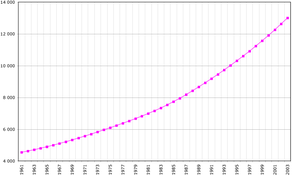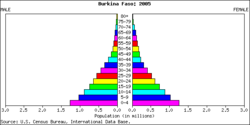Demographics of Burkina Faso
2007 Schools Wikipedia Selection. Related subjects: African Geography
Burkina Faso's 10 million people belong to two major West African cultural groups--the Voltaic and the Mande. The Voltaic are far more numerous and include the Mossi, who make up about one-half of the population. The Mossi claim descent from warriors who migrated to present-day Burkina Faso and established an empire that lasted more than 800 years. Predominantly farmers, the Mossi are still bound by the traditions of the Mogho Naba, who hold court in Ouagadougou.
About 12,000 Europeans reside in Burkina Faso.
Most of Burkina's people are concentrated in the south and centre of the country, sometimes exceeding 48 per square kilometer (125/sq. mi.). This population density, high for Africa, causes annual migrations of hundreds of thousands of Burkinabe to Côte d'Ivoire and Ghana for seasonal agricultural work. About a third of Burkinabe adhere to traditional African religions. The introduction of Islam to Burkina Faso was initially resisted by the Mossi rulers. Christians, predominantly Roman Catholics, are largely concentrated among the urban elite.
Few Burkinabe have had formal education. Schooling is free but not compulsory, and only about 29% of Burkina's primary school-age children receive a basic education. The University of Ouagadougou, founded in 1974, was the country's first institution of higher education. The Polytechnical University in Bobo-Dioulasso was opened in 1995.
Demographic data from the CIA World Factbook
Population
- 13,902,972
- Note: estimates for this country explicitly take into account the effects of excess mortality due to AIDS; this can result in lower life expectancy, higher infant mortality and death rates, lower population and growth rates, and changes in the distribution of population by age and sex than would otherwise be expected (July 2006 est.)
Age structure
- 0-14 years: 46.8% (male 3,267,202/female 3,235,190)
- 15-64 years: 50.7% (male 3,513,559/female 3,538,623)
- 65 years and over: 2.5% (male 140,083/female 208,315) (2006 est.)
- 15-64 years: 50.7% (male 3,513,559/female 3,538,623)
Population growth rate
- 3% (2006 est.)
Birth rate
- 45.62 births/1,000 population (2006 est.)
Death rate
- 15.6 deaths/1,000 population (2006 est.)
Net migration rate
- 0 migrant(s)/1,000 population (2006 est.)
Sex ratio
- At birth: 1.03 male(s)/female
- Under 15 years: 1.01 male(s)/female
- 15-64 years: 0.99 male(s)/female
- 65 years and over: 0.67 male(s)/female
- Total population: 0.99 male(s)/female (2006 est.)
- Under 15 years: 1.01 male(s)/female
Infant mortality rate
- Total: 91.35 deaths/1,000 live births
- Male: 99.17 deaths/1,000 live births
- Female: 83.3 deaths/1,000 live births (2006 est.)
- Male: 99.17 deaths/1,000 live births
Life expectancy at birth
- Total population: 48.85 years
- Male: 47.33 years
- Female: 50.42 years (2006 est.)
- Male: 47.33 years
Total fertility rate
- 6.47 children born/woman (2006 est.)
HIV/AIDS
- Adult prevalence rate: 4.2% (2003 est.)
- People living with HIV/AIDS: 300,000 (2003 est.)
- Deaths: 29,000 (2003 est.)
- People living with HIV/AIDS: 300,000 (2003 est.)
Major infectious diseases
- Degree of risk: very high
- Food or waterborne diseases: bacterial and protozoal diarrhea, hepatitis A, and typhoid fever
- Vectorborne disease: malaria is a high risk in some locations
- Water contact disease: schistosomiasis
- Respiratory disease: meningococcal meningitis (2005)
- Food or waterborne diseases: bacterial and protozoal diarrhea, hepatitis A, and typhoid fever
Nationality
- Noun: Burkinabe (singular and plural)
- Adjective: Burkinabe
Ethnic groups
- Mossi over 40%, Gurunsi, Senufo, Lobi, Bobo, Mande, Fulani
Religions
- Muslim 50%, Christian (mainly Roman Catholic) 30%, Indigenous beliefs 20%
Languages
- French (official), native African languages belonging to Sudanic family spoken by 90% of the population
Literacy
- Definition: age 15 and over can read and write
- Total population: 26.6%
- Male: 36.9%
- Female: 16.6% (2003 est.)
- Total population: 26.6%

